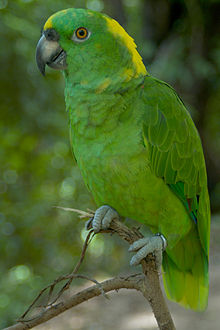Yellow-naped amazon
This article needs additional citations for verification. (September 2011) |
| Yellow-naped amazon | |
|---|---|

| |
| At Roatan Tropical Butterfly Garden, Honduras | |
| Scientific classification | |
| Kingdom: | |
| Phylum: | |
| Class: | |
| Order: | |
| Superfamily: | |
| Family: | |
| Subfamily: | |
| Tribe: | |
| Genus: | |
| Species: | A. auropalliata
|
| Binomial name | |
| Amazona auropalliata (Lesson, 1842)
| |
| Synonyms | |
|
Amazona ochrocephala auropalliata | |
The yellow-naped amazon or yellow-naped parrot (Amazona auropalliata) is an amazon parrot sometimes considered to be a subspecies of yellow-crowned amazon, Amazona ochrocephala (Gmelin, 1788).
Deforestation is reducing the number of these parrots in the wild together with illegal removal of young for the pet trade. This parrot readily mimics sounds, and in captivity this includes human speech, which is probably the reason it is popular in aviculture. Like all parrots, however, mimic abilities vary greatly between individuals.
Description
The yellow-naped amazon is distinguished by its green forehead and crown and a yellow band across the lower nape (back part of neck) and hindneck. The beak is dark gray and is paler towards the base of the upper mandible. The feet are also dark gray.
Taxonomy
Three subspecies are recognized:
- Amazona a. auropalliata: Southern Mexico to north-western Costa Rica.
- Amazona a. parvipes: Mosquito Coast in eastern Honduras and north-eastern Nicaragua.
- Amazona a. caribaea: Bay Islands, Honduras.
Range and habitat
It is found along the Pacific coast from southern Mexico south to northern Costa Rica.



In common with many parrot species, it feeds on nuts, berries, seeds, and fruit.
In captivity
Yellow-naped amazons are highly sought after for their talking ability and playful personalities. They are also known for nest-protective behaviors that often lead them to bite. This is particularly common in males during the breeding season. While they do not always handle emotions well, they will signal when stressed or over excited by spreading (fanning) their tail and eye pinning (contracting and expanding the pupils of their eyes). If they are allowed to calm down before they are handled, bites are not common. Yellow Napes, as with many other parrots, tend to bond with one member of a household and may be jealous of others.
Yellow Nape parrots do enjoy the stimulation of interacting with people however. The more they are socialized the more comfortable they will be around humans and animals.
Yellow Nape parrots are cavity nesting birds [2] in their wild habitat, therefore they enjoy chewing. Because of this they should be supplied with bird safe and non toxic toys to chew. They also enjoy manipulating objects and interacting with them.
A rare blue mutation of the yellow-naped amazon is known to exist, in which the entire body is turquoise in color.[3]

